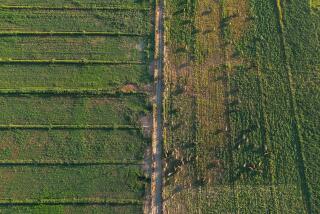Industry Report Adds to Dispute Over Use of Acid
- Share via
A chemical industry-sponsored report says the impact of a large release of acutely hazardous hydrofluoric acid can be limited by tall walls that would hem in the resulting gas cloud and by fine droplet water sprays that would dilute it.
The report is intended to aid the design of improved safety systems at facilities using the acid throughout the nation. It was written by K. W. Schatz of the Mobil Research and Development Corp. and Ronald P. Koopman of the Lawrence Livermore National Laboratories, and describes the results of laboratory experiments, wind tunnel tests in the Nevada desert and computer simulations.
Federal officials have said an uncontrolled release of the chemical, which is used in large quantities at three plants in the South Bay, could be as deadly as the 1984 Bhopal gas disaster.
The South Coast Air Quality Management District is considering banning or restricting the use of hydrofluoric acid, and industry officials are expected to use the report to fight any proposed ban.
Inadequate Spray Systems
In May, a senior environmental engineer for an AQMD task force studying hydrofluoric acid warned that three of the major Los Angeles County users--including an Allied Signal Corp. plant in El Segundo--lack adequate water spray systems to contain a major release.
In Torrance, approval of a March, 1990, ballot measure would force Mobil Oil Corp. to switch to less deadly sulfuric acid, and a city lawsuit against Mobil cites the refinery’s use of the substance as justification for needing more control over the facility. Mobil generally stores more than 29,000 gallons of the acid at the refinery.
Mobil hailed the report’s conclusions as corroborating its position that hydrofluoric acid can be used safely.
“Great! Great!” said Mobil spokesman Jim Carbonetti, when he was told of the report’s main findings. The refinery is planning to increase its water spray system.
But Ralph Nutter, the attorney for Torrance in its lawsuit, noted that Mobil was one of the sponsors of the industry group that produced the report and added that the tests “appear to be absolutely inconclusive.”
“As far as I am concerned,” he said, “they aren’t any safer. It doesn’t tell us a damn thing.”
The Times obtained a copy of the report Wednesday from the Torrance Fire Department.
The largest users of hydrofluoric acid in the county are Mobil, the Ultramar Refining plant in Wilmington, Golden West Refining Co. and the Powerine Oil Co. refinery in Santa Fe Springs and the Allied Signal plant in El Segundo.
About half the nation’s oil refineries use hydrofluoric acid as one of two possible catalysts that boosts the octane of unleaded gasoline; the other is sulfuric acid. Allied Signal uses the acid to manufacture refrigerants.
David Schwien, a member of the air quality agency’s task force studying hydrofluoric acid, said the three facilities that lack adequate water sprays to fight a major release are the Powerine, Golden West and Allied Signal plants. Schwien said Wednesday that he had not seen the report.
Texas and Torrance Accidents
The AQMD task force was created in January, 1988. Concern about a release of the acid was triggered by the largest accident involving hydrofluoric acid, a 35,000-gallon release from the Marathon refinery in Texas City, Tex., on Oct. 30, 1987, and by a thunderous explosion and two-day fire at Mobil’s Torrance refinery on Nov. 24 and 25, 1987, during which 100 pounds of the substance were released.
Appearing at the AQMD board meeting that created the hydrofluoric acid task force, environmentalists cited the Texas City release, which injured 650 people, forced the evacuation of 3,000 residents and defoliated trees for miles, as having had the potential to be as catastrophic as the Bhopal methyl isocyanate gas release in which 3,000 were killed and 200,000 injured in 1984.
The Environmental Protection Agency recently joined in the conclusion, listing the Texas City release among disasters that had the potential to have been as bad as Bhopal.
The environmentalists also pointed to industry-sponsored tests conducted in the Nevada desert in 1986 that showed that a two-minute, 1,000-gallon spill of hydrofluoric acid could form a dense, ground-hugging cloud of gas and small droplets that could be lethal up to five miles downwind. They noted that hundreds of thousands of people live within five miles of the facilities using the acid in the county.
Wind Tunnel Experiments
In 1988, a group of hydrofluoric acid users and manufacturers followed the earlier tests with wind tunnel experiments in Nevada on water sprays, as well as computer simulations of releases blown against vapor barriers, such as walls.
The report is a summary of the findings.
Confirming preliminary results released last year, it said that drenching a hydrofluoric acid release with large amounts of fine water sprays could turn much of an escaping gas cloud into less dangerous puddles of diluted hydrofluoric acid. A ratio of 40 times as much water as acid could cut the escaping gas to a 10th of its original concentration, the report said.
The report added that experiments showed that: Water sprays facing upwards are more effective than downward sprays; smaller droplets are better than larger droplets, and sprays closer to the release are more helpful than sprays farther away.
Fire-Hose Sprays
Because water sprays might be dislodged by an explosion, the experimenters also studied fire-hose sprays, which have much larger droplets but can be moved into position after a blast.
The study found that such sprays provide some protection but are not as effective as the fine droplet sprays in general.
“The main conclusion from the program is that water sprays and (fire nozzles), properly designed and applied, can be used in mitigating an HF aerosol leak with high efficiency,” the report said.
In a section on vapor barriers, it said that a four-sided enclosure with an open top--known as a “vapor box”--could also reduce concentrations of acid gas and delay the arrival of a gas cloud at a downwind spot by 50 seconds to eight minutes and 20 seconds.
Vapor Box Effectiveness
Just outside the enclosure, the concentrations could be one fourth to one 15th as strong as they would be without any enclosure. Farther away, vapor barriers would have much less effect on gas concentrations, according to the report.
The report noted that the drawback to vapor boxes is that concentrations inside the vapor box would be higher.
The best water spray system currently operating at a major hydrofluoric acid user in the county is the 9,000-gallons-a-minute deluge system at the Ultramar refinery, which could reduce concentrations of a leak of 225 gallons a minute by 90%.
Using the same 90% standard, the Mobil refinery water spray system could similarly reduce a hydrofluoric acid leak of 78 gallons a minute. The water system at Allied Signal’s plant could mitigate a leak of 21 gallons a minute, and the one at the Golden West refinery could dilute by 90% a leak of eight gallons a minute. The Powerine refinery, which also uses hydrofluoric acid, has no spray system.
More to Read
Inside the business of entertainment
The Wide Shot brings you news, analysis and insights on everything from streaming wars to production — and what it all means for the future.
You may occasionally receive promotional content from the Los Angeles Times.










